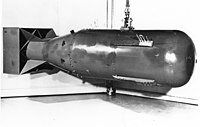
Photo from wikipedia
Abstract Numerical simulations using large eddy simulation (LES) and Unsteady Reynolds Averaged Navier–Stokes (URANS) are carried out to identify the underlying mechanisms that govern the early soot evolution process in… Click to show full abstract
Abstract Numerical simulations using large eddy simulation (LES) and Unsteady Reynolds Averaged Navier–Stokes (URANS) are carried out to identify the underlying mechanisms that govern the early soot evolution process in an n-dodecane spray flame at 21% O2 by molar concentration. A two-equation phenomenological soot model is used here to simulate soot formation and oxidation. Both ignition delay time (IDT) and lift-off length (LOL) are found to agree with experimental measurements. The transient evolution of soot mass, in particularly the soot spike phenomenon, is captured in the present LES cases, but not in the URANS cases. Hence, a comparison of numerical results from LES and URANS simulations is conducted to provide a better insight of this phenomenon. LES is able to predict the rapid increasing soot mass during the early stage of soot formation due to having a large favorable region of equivalence ratio ( ϕ > 1.5 ) and temperature ( T > 1800 K ) for soot formation. This favorable region increases and then decreases to reach a quasi-steady state in the LES case, while it continues to increase in the URANS simulation during the early time. In addition, the soot spike is a consequence of the competition between soot formation and oxidation rates. The time instance when the total soot mass reaches peak value coincides with the time instance when the total mass of soot precursor reaches a plateau. The soot spike is formed due to the continuous increase of oxidizing species in the LES case which leads to a more dominant oxidation process than the formation process.
Journal Title: Fuel
Year Published: 2021
Link to full text (if available)
Share on Social Media: Sign Up to like & get
recommendations!